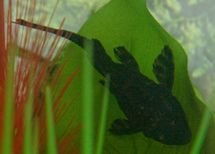We set up our tank several weeks/months ago, with a white sand substrate, but chose to replace it with gravel and have done so.
During the process we re-located the tank into a more suitable position, and left it for the water to settle, for another week or two.
Last friday, we visited our LFS, purchased out first batch of fish.
5 Neon Tetra's
5 Black Tetra's
3 Cory's
1 Plec
returned home and added these to the tank, and all was fine, and we chose to add some more fish a few days later, in total now housing,
15 neons,
5 black tetra's
3 corys
1 plec
4 guppys.
However, I returned home from a day or two later to find one of our Neons dead, and removed him from the tank. The following day, one of the cory's appeared quite subdued, and on closer inspection, appeared to have signs of white spot. I contacted the LFS we bought them from, who asked to see a water sample, and upon testing found the NO3 to be high.
Their advice was to add 10ml of JBL denitrol everyday, which should increase bacteria in the tank to break down the NO3, and to trust them, and not conduct a water changes, and refrain from feeding them for several days...
We followed their advice, however the two other cory's began to show simular behaviour, so last night decided to conduct a small water change (about 10l, in our 60l tank), checking the NO3 again today it still remains too high, and have since changed another 10l of water.
What I think we have done is prematurely over stocked the tank, and it hasn't finished it's cycle. (which might explain the cloudy/hazy water prior to adding fish)
Since carrying out the water changes the fish seem to be improving.
Do I keep conducting small water changes until I see the NO3 level off?
What is the best way to conduct a Waterchange? I've been filling a bucket with water, adding aquasafe and leaving it overnight to warm, as the tank is at room temprature at the minute.
What is the best value for money testing kit available? (budget about £20-£30)
Cheers in advance
Dave - currently in the dog house for killing the fish
During the process we re-located the tank into a more suitable position, and left it for the water to settle, for another week or two.
Last friday, we visited our LFS, purchased out first batch of fish.
5 Neon Tetra's
5 Black Tetra's
3 Cory's
1 Plec
returned home and added these to the tank, and all was fine, and we chose to add some more fish a few days later, in total now housing,
15 neons,
5 black tetra's
3 corys
1 plec
4 guppys.
However, I returned home from a day or two later to find one of our Neons dead, and removed him from the tank. The following day, one of the cory's appeared quite subdued, and on closer inspection, appeared to have signs of white spot. I contacted the LFS we bought them from, who asked to see a water sample, and upon testing found the NO3 to be high.
Their advice was to add 10ml of JBL denitrol everyday, which should increase bacteria in the tank to break down the NO3, and to trust them, and not conduct a water changes, and refrain from feeding them for several days...
We followed their advice, however the two other cory's began to show simular behaviour, so last night decided to conduct a small water change (about 10l, in our 60l tank), checking the NO3 again today it still remains too high, and have since changed another 10l of water.
What I think we have done is prematurely over stocked the tank, and it hasn't finished it's cycle. (which might explain the cloudy/hazy water prior to adding fish)
Since carrying out the water changes the fish seem to be improving.
Do I keep conducting small water changes until I see the NO3 level off?
What is the best way to conduct a Waterchange? I've been filling a bucket with water, adding aquasafe and leaving it overnight to warm, as the tank is at room temprature at the minute.
What is the best value for money testing kit available? (budget about £20-£30)
Cheers in advance
Dave - currently in the dog house for killing the fish





 Although when I say he... I think I mean she.
Although when I say he... I think I mean she.